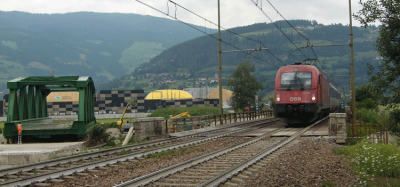High requirements for safe and reliable track systems
Posted: 29 December 2006 | | No comments yet
The wheel/rail system is on the right way to ensure mobility for the future. To compete with road traffic, reliable track systems are necessary which require not only renewal of worn and fatigue stressed track components but also the introduction of optimized and newly developed system innovations as well as respective best practice maintenance concepts. Decisive for economic structures are the life cycle costs. However, it should be considered that higher investment costs can be equalized by lower maintenance costs.
The wheel/rail system is on the right way to ensure mobility for the future. To compete with road traffic, reliable track systems are necessary which require not only renewal of worn and fatigue stressed track components but also the introduction of optimized and newly developed system innovations as well as respective best practice maintenance concepts. Decisive for economic structures are the life cycle costs. However, it should be considered that higher investment costs can be equalized by lower maintenance costs.
The wheel/rail system is on the right way to ensure mobility for the future. To compete with road traffic, reliable track systems are necessary which require not only renewal of worn and fatigue stressed track components but also the introduction of optimized and newly developed system innovations as well as respective best practice maintenance concepts. Decisive for economic structures are the life cycle costs. However, it should be considered that higher investment costs can be equalized by lower maintenance costs.
Special requirements exist for each railway application which can be best met by individual tracks for heavy haul, high-speed or light railway systems. Heavy haul causes extreme wear by high vertical and lateral forces. High-speed traffic causes dynamic effects, accelerations and flying ballast stones on ballasted tracks while tramways often have to withstand both forces by rail vehicles as well as by cars.
The main advantages of a conventional ballasted track are its low investment costs, its ability to carry very high axle loads at low speeds and the relatively simple possibility to correct alignment. When looking in the past it can be stated that new developments and adaptations to meet challenges in customers’ needs have been performed in Germany in intervals of approximately 20 years.
During 1950, the most important innovations in the history of railway construction techniques were introduced. The replacement of wooden sleepers by concrete sleepers initiated continuous welding of the rails due to the higher lateral track resistance, which reduces the danger of track buckling at high temperatures. Plus, the heavier weight of the sleepers made it necessary to develop machines for track maintenance and renewal, which ensured steady progress in highly mechanized maintenance practices for the future.
In 1970, regular ICE-traffic (with a maximum speed of 200 km/h) was introduced at German Railways (DB) and the main lines were strengthened by rail profile UIC 60, the 2,60m long prestressed monoblock sleepers B 70 with elastic W-fastenings and an additional granular protection layer with low water permeability under the ballast bed of existing tracks with very poor subgrade conditions to protect the subgrade from often observed softening due to rain water infiltration.
Two decades later, the maximum speed was increased to 250 km/h by ICE-traffic on newly constructed 430km long high-speed lines (mixed traffic) in the same ballasted track structure. Observations demonstrated that after three years of service, ballast wear and pulverization (white spots) required much more maintenance than initially scheduled. Similar observations with unexpected ballast deterioration were made on the first TGV line (Paris-Lyon) in France and on the first Shinkansen line (Tokio-Osaka) in Japan. This demonstrates that at high-speeds the standard ballasted track structure must be optimised to improve its response under dynamic loading. From measurements of the vertical vibration velocity on top of the ballast bed, an increase of the effective rms-values by a factor of 2 with rising speed from 160 km/h to 250 km/h was obvious. With the introduction of more resiliency in the track structure, the vibrations can be reduced either by high resilient fastening systems (in Germany the conventional rigid rail pads were successfully substituted by resilient rail pads) or by sleeper pads or by sub-ballast mats at the bottom of the ballast bed. The latter method was performed in Germany on bridges as additional ballast distortion by bridge bending and movement due to the minimization of temperature change.
On the other hand, ideally suited for high-speed is optimised ballastless track. In Germany, more than 800km of slab track exists. In May 2006, the newest high-speed line Nuremberg-Ingolstadt (v = 300 km/h) in a length of 89km was opened for service. Numerous modifications of ‘Rheda’-systems and structures with prefabricated concrete slabs (coupled continuously at the joints) were developed by German construction and engineering companies. These structure types shall be used in large high-speed projects such as in Asia which is connected with a respective flow of know-how for best practice.
Railway companies should encourage the rail industry to develop, in cooperation with research institutes, innovative systems and components which allow testing in revenue tracks to achieve real ‘permanent way’ – a safe and reliable option for future requirements.
About the author
Günther Leykauf is Professor at the Chair and Director of the Institute for Construction of Roads, Permanent Way and Airfields at Munich University of Technology. Research activities focus on the structural design and analysis of bearing capacity and deflection behaviour of super-structures. Innovative system components for ballasted as well as for slab tracks have been developed and optimized at the testing institute. These research reports are a fundamental basis for approval by EBA for application in revenue service tracks.







